what process will help adjust your sights to hit the bulls-eye consistently?
How to Escape Target Panic By Opening Day
Offset your rehab At present to be ready for fall hunts.
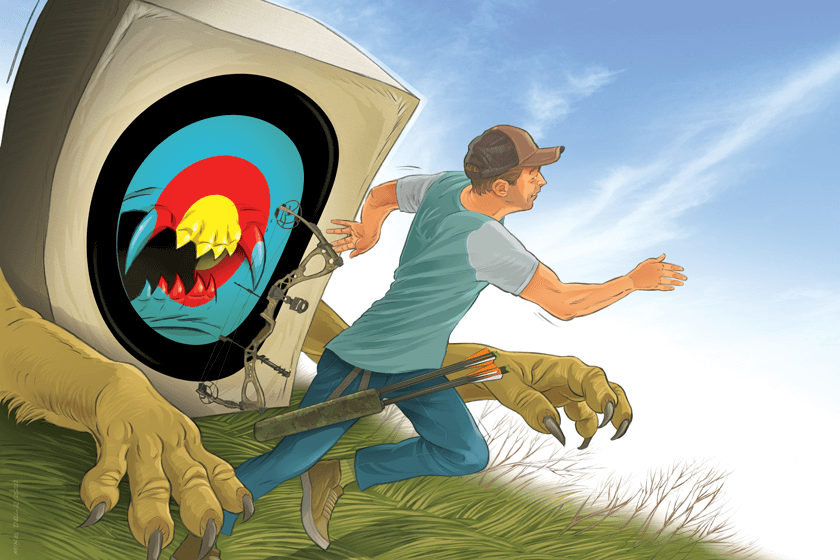
Even the best shooters tin can be thrown off their game past an untimely case of target panic. We'll help you place the problem, and then fix information technology once and for all. (Illustration by Mike Del Rizzo)
July 22, 2021
Target panic.
There, my friends, are the 2 scariest words in archery. If you know, you lot know. And if you don't? Well, simply pray you never practice.
The effects of target panic tin be so debilitating to an archer's performance that most speak the words only in hushful tones, if they are spoken at all. In fact, nigh bowhunters would rather discuss politics, religion or rifle hunting than dive into the ugly details of this unpleasant topic.
Notwithstanding with target panic an epidemic within our ranks, this is a conversation that desperately needs to exist had. Much similar puss inside an abscess, the but way to deal with target panic is to betrayal it. No, the procedure isn't pretty, but the short-term pain is worth the long-term proceeds.
Besides, summer is the perfect time to accost your target-panic problems. Getting over this malady isn't an overnight procedure, just with several months between now and opening day, you've got plenty of time to cover the journey and not only be shooting as adept equally you used to — but better than you ever accept — come fall.
With that, allow'south accept out our scalpels and get to work.
What Is Target Panic?
It is oft said in that location are only two kinds of archers; those who have target panic and those who will. I don't know if that'southward entirely accurate, only I'd say it isn't as well far off the mark.
At its core, target panic is a class of anxiety related to shooting your bow, or, more specifically, accurately shooting your bow. In other words, yous experience feet when aiming the bow and releasing the pointer. This anxiety is directly connected to conscious and/or unconscious anticipation of the shot and a want to control that moment when the bowstring is released.
Target panic manifests itself in a variety of ways, and the more of import the shot — such as during a tournament or when a large cadet is standing broadside — the more pronounced it can be. In balmy cases, much of this anxiety is subconscious and may announced only occasionally. In acute cases, this feet can literally overwhelm the senses, resulting in the inability not simply to hit where you are aiming but to hit the target at all, even from close range. As someone who has suffered from severe target panic in the past, I tin can tell you it is a very helpless, lonely place to be.
Diagnosing Target Panic
1 of the near common symptoms of target panic is "freezing," or the seeming impossibility of placing your sight pin where you desire your arrow to get. Once at full draw, just about every archer begins aiming past pointing at the target and either coming up or down onto the called point of affect. Those suffering from target panic will ofttimes freeze several inches in a higher place or below their desired point of aim. If you have ever experienced this, it can experience as though an invisible force is literally holding your arm muscles dorsum, preventing you from placing the sight pin where you desire it to get.

Meanwhile, your body apace tires as you struggle to hold the bow steady and movement the pin into proper position, leading to an incredible sense of urgency to make the shot. The end result is that you either release the cord without always being settled on target or attempt what is often referred to as a "drive-by shooting," in which you apace wiggle the bow arm in the direction of the balderdash's-eye while attempting to squeeze the release trigger the instant the sight pivot meets it. In either example, the cease result is poor accurateness; arrows that consistently hit high or low or extremely erratic shooting that sometimes misses the target altogether.
Interestingly, back when I was suffering from astringent target panic, if I told myself I wasn't going to shoot, I could draw, anchor and place the pivot exactly where I wanted. But if I let down and repeated the process with the intention of shooting, bringing the pivot to the verbal same spot was incommunicable. Talk about frustrating!
Other common symptoms of target panic include an unexplained want to shoot before settling the pivot on target, taking an abnormally long fourth dimension to shoot or even the disability to shoot at all. Lastly, there is the ever-pop "punching" of the trigger (the inability to execute a surprise release) and telltale "flinching" among archers who physically react as if the shot has been fired when in fact the pointer is notwithstanding on the string.
Overcoming Target Panic
OK, and then nosotros've got some idea of what target panic is and how it manifests itself. What we really want to know is how to cure it. Well, the showtime step to solving a trouble is albeit you have one. The second stride is albeit you lot tin can't solve it on your own; you're going to demand help.
Unfortunately, many bowhunters deny they are suffering from target panic, or believe they tin can overcome it by sheer volition power. As a result, many people only seek help later on striking rock bottom. For example, by the time I sought advice from my friends Randy Ulmer and John Dudley — both globe-form shooters — my target panic had gotten so bad I struggled to consistently hitting a Cake target from just twenty yards away!
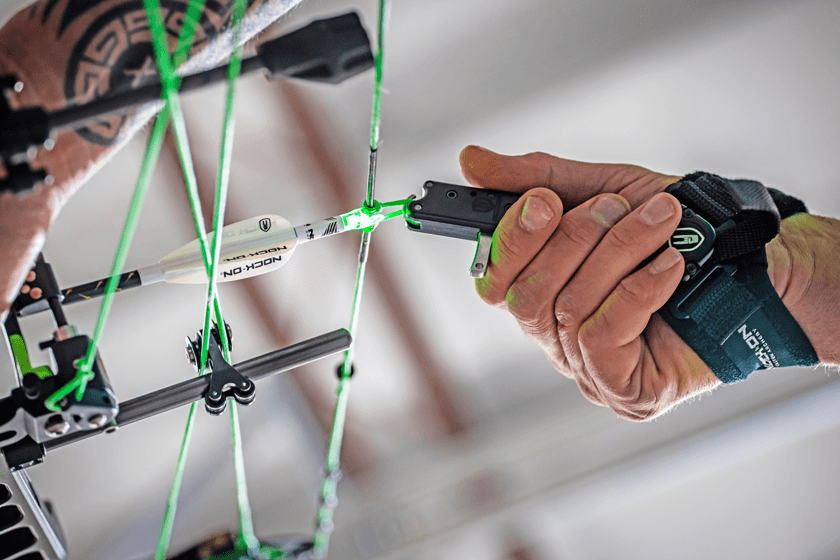
If you are a basket case like I was, you accept my sympathy. Hopefully, you lot aren't about that bad. Perhaps you aren't experiencing any symptoms of target panic at all. If and so, you may be tempted to ignore this article completely. However, I urge you not to do that, because the same steps involved in helping people overcome target panic volition help prevent you from getting information technology in the starting time place!
What I know now, just didn't know so, was that my entire idea process about shooting was incorrect. I was obsessed with momentarily getting the sight pin on the bull's-middle and hitting the release trigger every bit soon as possible. However, a proficient bow shot is not a moment; information technology's a process. And when that process is executed correctly, it happens freely, hands and with consistently expert results.
When you are suffering from target panic, that is a sure sign your shot process has gone haywire. So, the fundamental to the cure is trigger-happy that process downwardly and rebuilding information technology the correct way.
Surprise, Surprise!
The No. i piece of advice given to those suffering from target panic — and the very advice Ulmer and Dudley gave me years ago — is to get a hinge release and learn to use it. This is excellent instruction, as a swivel release will teach y'all the proper way to execute a shot and force you to apply proper form with every arrow you shoot!
Unfortunately, I am convinced this advice, while valid, is the No. 1 reason and so many people who suffer from target panic don't become the aid they need. Simply put, people are stubborn. Archers are no exception, and I can't tell you lot how many bowhunters I've known who — despite raging target panic — apartment-out refused to abandon their wrist-strip, alphabetize-finger release aids.
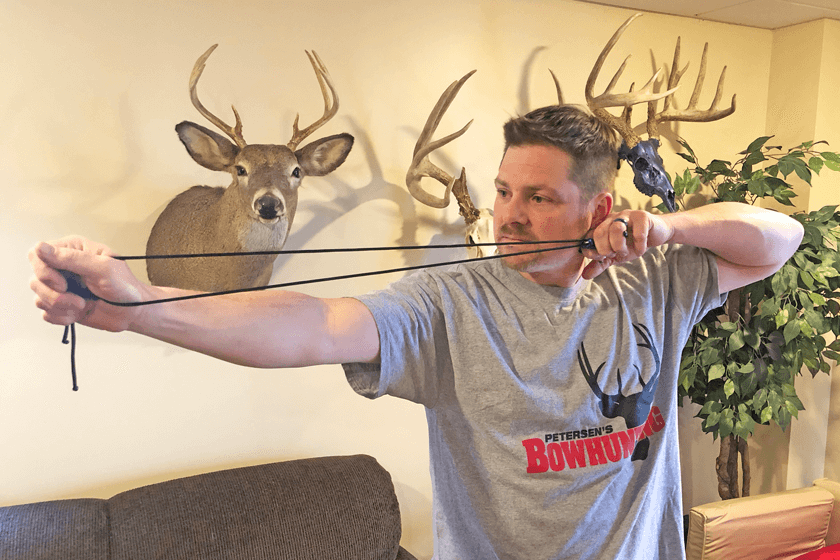
Release aids with index-finger triggers are, by far, the well-nigh popular way amid bowhunters. Sadly, relatively few who use them truly sympathise how to execute a surprise release with i. Punching the trigger is far more than common, and because there'due south literally no way for the left hand not to know what the right mitt is doing while shooting, it'due south no surprise so many archers anticipate the shot and unknowingly develop feet.
Thankfully, over the past several years, release-aid makers have introduced a number of new wrist-strap models (see sidebar) that tin be used just like swivel-manner or tension-activated releases that force shooters to "pull through" the shot in society to release the bowstring. Although a hinge or resistance-activated release is a great grooming aid — and one I wholeheartedly recommend — I believe these new offerings volition help many more archers finally enter rehab and regain their shooting confidence.
Regardless of which model y'all cull, the first step in rebuilding your shot process is to put down your traditional, trigger-activated release and choose 1 that allows you to execute the shot via back tension or resistance (gradually increasing the corporeality of pressure against your bow's draw stops once at total depict). Remember, much of the anxiety associated with target panic is wrapped upward in "firing" the shot, so we demand to completely eliminate the distraction the trigger creates in the shot procedure.
Once you have your new release, you must learn to use it properly. The best, and easiest, fashion to do this is by making a do "bow" with a loop of paracord equal to your depict length. Place your bow hand in one stop and attach your release to the other. Agree your bow hand out equally you would while shooting, anchor your release mitt confronting your face and slowly pull through "the shot" until the release activates.
The moment of release should catch you by surprise, because you lot are not making it happen with a specific, witting deed (squeezing a trigger). Repeat the process until it becomes second nature. Each shot should feel completely natural, with no anxiety.
Merely after the functioning of your new release aid has been mastered should you use information technology with your bow. However, that doesn't hateful you are ready to step onto the range and shoot targets. Instead, start out with a prolonged period of what is called "blank-bale shooting." This ways continuing in front of a target with no aiming points, roughly five feet away, and simply drawing the bow and executing the shot without whatsoever concern about where the arrow hits.

At this signal in your rehab, accuracy is irrelevant. In fact, y'all shouldn't even be aiming! The purpose of this exercise is to reprogram your brain and learn the "feel" of a completely natural, relaxed shot process that culminates with a surprise release. Many archery coaches recommend this stage of training should exist done with your eyes closed, removing any distractions caused by what you lot see and eliminating the temptation to stare at your sight pin and selection an imperfection or onetime arrow hole in the target as an aiming indicate.
Keeping your optics closed likewise allows you to concentrate on every stride of your shot process, from setting your feet and bow paw to drawing the bow, anchoring, slowly building tension between your bow arm and release arm as you pull through the shot and maintaining steady follow-through until the arrow hits the target. Interestingly, Ulmer and many other top-level archers will take several warm-upwards shots using this method at the start of every shooting session or before a big competition as a way to relax and remind themselves exactly what the perfect shot sequence feels like.
Remember, the whole point of this rehab is to rebuild your shot from the ground up. Yous want to go and so intimately familiar with every footstep that it happens without thinking. At that place is no universally agreed upon fourth dimension frame for this first stage of the rebuilding process, but committing several weeks to it will non simply give yous a welcome break from the shooting-related stress yous've been experiencing simply also help engrain the muscle memory of what a relaxed shot feels like.
Let It Float
Now that you've gotten comfy with your new release and what information technology feels like to draw, anchor and patiently pull through the shot, you are going to be very eager to start shooting targets. Don't do it! Remember, you are on a long journey to overcome target panic; if you rush the process, you'll find yourself right back where you were.
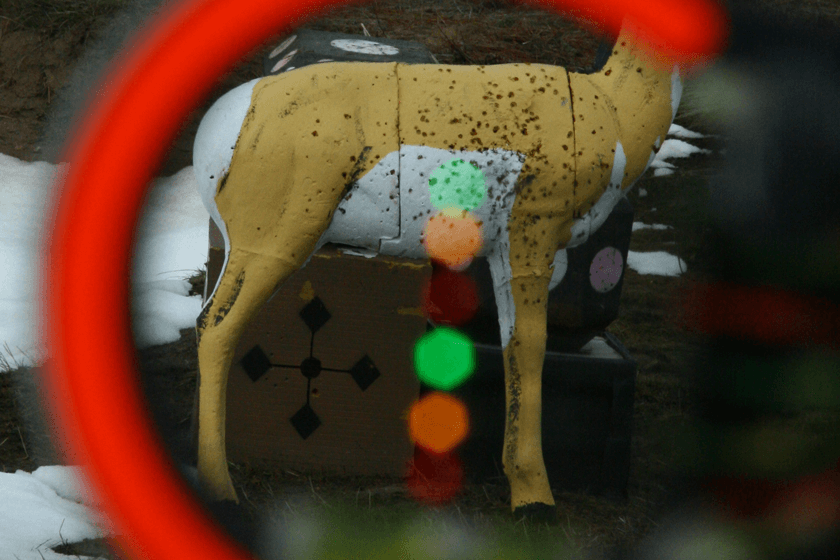
Instead, offset out but v yards from a target, draw your bow and but aim at the balderdash'due south-center. Concentrate on keeping your pin as close to the centre of your target as possible, but also understand that no ane — not fifty-fifty world-grade shooters — can remain completely still at full depict. Accept the fact that your pin will bladder, and as it does, only bring it back toward the centre, over and over over again. Because you lot are then close to the target, your pin should remain very shut to the middle even as it moves. Hold for roughly fifteen seconds, let the bow down and balance. Then, echo the process until you go totally comfortable watching your sight pin float on the target.
One time you are completely comfortable and confident in holding your pin on target at very close range, you can gradually increase your distance from the target and repeat this exercise. Remember, the further you get from your target, the smaller it will appear and the more noticeable the motion of your sight pin volition be. Again, there is no accented answer for how long this step of your rehab should take. Progress slowly and remind yourself that it'southward perfectly natural for your pivot to float as you repeatedly bring it dorsum toward the eye.
Connect the Dots
If y'all've taken this process seriously, you've likely spent the past month or more proving to yourself that y'all can both aim your bow and release your bowstring while feeling admittedly no pressure. The final footstep in your rehab process is to take these 2 critical steps of the shot sequence and put them back together.
Every bit you did while aiming and releasing, start at very shut range. Five yards is a adept starting point, and suit your sight so your top pivot hits the bull's-eye at that distance. Because yous are standing so close to the target, it should be like shooting fish in a barrel to keep your pin in the middle, and as a result, your results should be very good. You are now shooting at targets again, only this time, your conviction should exist sky high and you should feel no anxiety nearly the event.
In one case y'all are comfortable at five yards, you tin gradually move back to 10 yards so 20 yards, remembering to readjust your sight for the range. Although you are now keeping score once more, if just in your mind, don't be preoccupied with the accurateness of every arrow. Rather, remain focused on maintaining that "experience" of a perfect shot that you've been working on for the past month or more. Do your all-time to remain relaxed equally you scout the pin float and gradually pull through the shot until the release fires. Consider doing this with a single arrow, walking to the target to remember it in betwixt shots. This volition help you focus on every shot rather than beingness distracted by how well you are grouping arrows. In the long run, learning to trust and repeat that shot process will yield far better and more than consequent accuracy than the manner you used to shoot — and it will help prevent the render of those pesky target panic symptoms that sent you to rehab in the first place.
Assuming you still experience comfy, you lot can crank your bow back upwardly to your normal draw weight and resume regular exercise sessions at all typical hunting distances/angles/shooting positions in preparation for opening day.
Back in the Saddle
At this point, many people are tempted to believe they have been "cured" of target panic. Withal, I hold with Ulmer, who believes target panic is a lot similar alcoholism; y'all never truly cure it, you only exercise your all-time to steer clear of its furnishings.
In either instance, that means a daily commitment to the procedure that helped us get well, all the while avoiding old behaviors that tin can lead to a relapse. While information technology may be tempting to go back to your onetime, index-finger release aid at this point, I strongly encourage you to continue practicing, and even hunting, with a release that will reinforce practiced shooting form and help you avoid the anxiety that is always looking for an opening to creep back in.
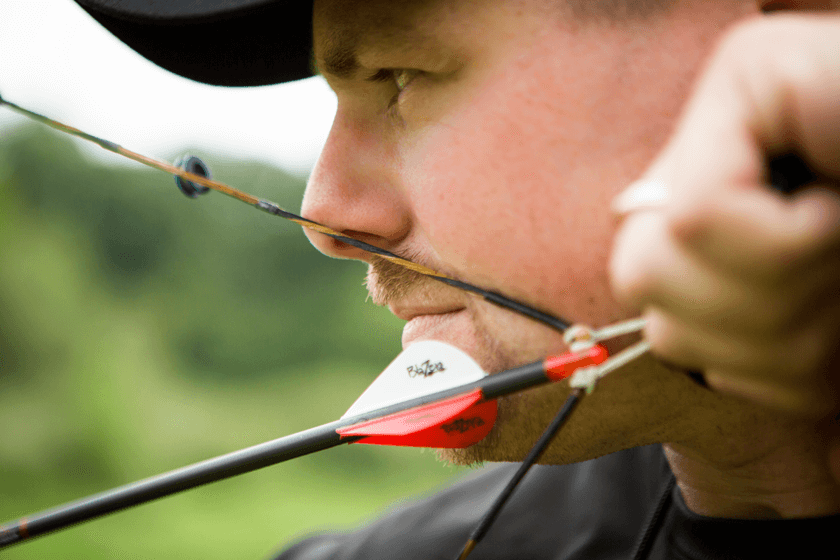
Back when I had my ain battle with target panic, I trained with a swivel release and eventually settled on a resistance-activated release for hunting. I found a resistance-activated release to be the perfect middle basis betwixt a hinge and a trigger release, because information technology both forces me to properly pull through the shot merely likewise allows me to shoot quickly when needed in bowhunting situations by pulling hard into the draw stops.
Other archers who accept struggled with target panic find they did much ameliorate after rehab past switching to a handheld, thumb-trigger release, and yes, many folks do merely fine with their tried-and-true index-finger release. Ultimately, yous have to decide what works all-time for you. Just be on the scout for the outset sign of target panic and nip it in the bud by going dorsum through the steps outlined here.
If you fully commit to this rehab programme now, I feel confident that by the fourth dimension you climb up in your tree saddle (or stand up) on opening day, you'll be shooting with less stress and more conviction than e'er. As a outcome, y'all'll be hitting more than vital areas and punching more tags, too.
Release Aids for Target-Panic Rehab
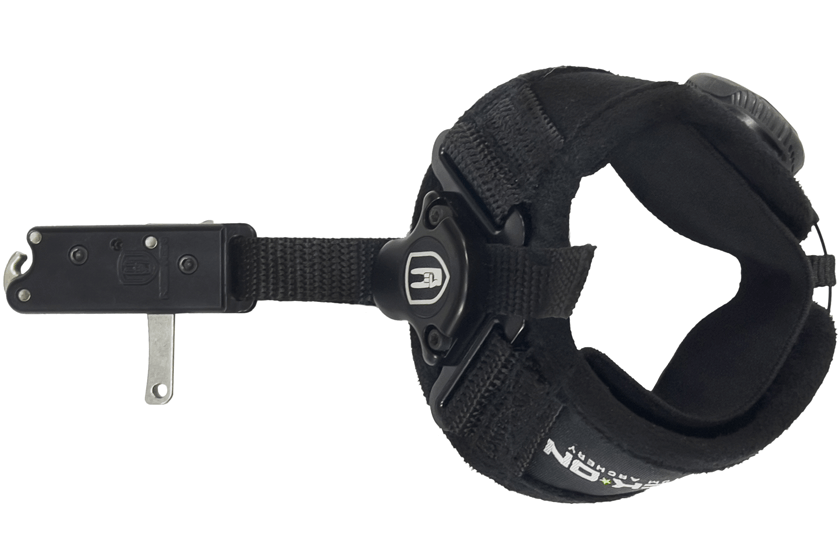
Nock On Custom Archery teamed up with the folks at Carter Enterprises to develop the all-new Dorsum Strap ($219.99; nockonarchery.com), a wrist-strap release aid designed to be shot just like Carter's handheld, tension-activated releases. Featuring a release head with the patent-awaiting Heart Pivot Trigger, the Back Strap is designed to exist shot by adjusting the activation tension several pounds over your bow's holding weight. Then, simply hook onto the bowstring, depict, pull the trigger and continue increasing tension until the shot fires. The Back Strap tin can too be shot just like a traditional index-finger release by adjusting the tension beneath your bow'south belongings weight, which volition cause the release to burn as soon as the trigger is pressed. The Back Strap as well features a BOA closure for like shooting fish in a barrel on/off and custom fit, a removable release head that can be flipped for employ by left- and correct-shooters and an adjustable connexion strap that can exist lengthened or shortened to fit archers of all sizes.
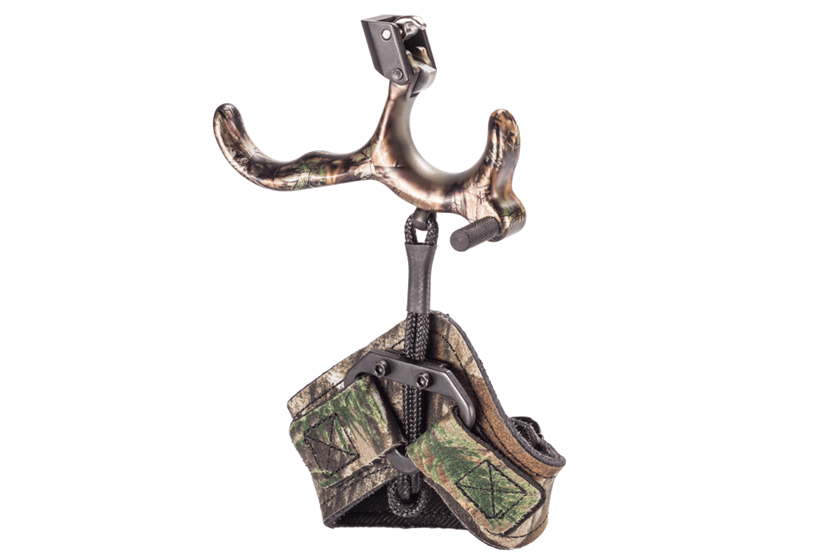
The Scott Archery Longhorn Hunter ($159.99; scottarchery.com) is the respond for bowhunters who want to shoot a hinge release. The Longhorn Hunter features a iii-finger hinge release fastened to a Realtree camo wrist strap with a cord that can be length adjusted for a perfect fit. This manner, archers tin can keep the familiarity of a wrist strap and keep the release at the gear up while enjoying the accuracy and shooting-form benefits of a hinge. Other highlights include adjustable release sensitivity (with or without click) and a knurled pollex knob that can exist flipped to accommodate left- and correct-handed shooters.
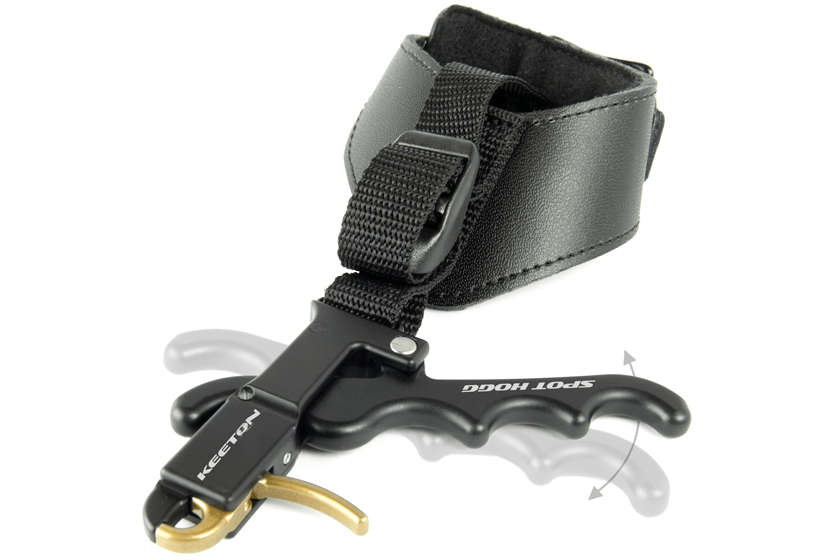
The Spot-Hogg Keeton ($139.99; spot-hogg.com) is a unique, wrist-strap, index-finger release with an integrated finger grip that allows yous to draw and shoot using more than just the shoulder to handle the weight. When the release length is adjusted properly, the archer can distribute the weight evenly betwixt the grip, wrist, arm and shoulder. At full depict, the grip pivots, quickly aligning the finger with the trigger. Once at full draw, the Keeton can be fired as a traditional index-finger trigger or used in tandem with the grip to gradually pull through until sufficient trigger pressure is achieved to release the bowstring.
Unlike traditional index-finger releases, the Tru-Fire ThruFire ($159.99; feradyne.com/trufire) has no obvious trigger and is designed to be shot by wrapping your index finger around the semicircular opening on the release stem. By increasing resistance at total describe, the trigger hidden inside the mail service comes into contact with your finger, assuasive archers to "pull through" the shot until the bowstring is released. The amount of tension needed to expose the trigger can exist adapted from 2-30 pounds via a setscrew, allowing you to customize the release's functioning for your bow setup and personal preference.
The T.R.U. Brawl Ten-Tension R/T ($189.99; truball.com) is a new wrist-strap, alphabetize-finger release that tin be shot in your choice of two means — both designed to promote good shooting form while fighting target panic. The release head features T.R.U. Brawl'southward Tri-Star Hook System that makes loading the release onto your nocking loop easy. There are likewise tension levers for the thumb and index finger. To shoot the release in pull-through mode, set the activation tension to five pounds over your bow'due south holding weight. And then, draw with both levers pressed and release them at ballast. From at that place, y'all just pull until the shot is fired. To shoot the release in relax tension mode, set up the release to fire 5 pounds below your bow'due south holding weight. Depict with both levers pressed and fire the shot simply by relaxing your thumb and index finger while aiming. In improver to adjusting the tension required to trigger the release, you can also adjust the spring tension on the thumb and index-finger levers to adjust your personal preference.

The Stan PerfeX Resistance ($269.95; ishootastan.com) is a handheld, resistance-activated release designed to aid shooters maintain great shooting habits. Simply adjust activation to your preferred amount to a higher place your bow'due south property weight and pull through the shot until the bowstring is released. The PerfeX too offers tons of customization and comes with attachments that allow you lot to employ the release in a three- or 4-finger configuration with adaptable finger sweep bending. There are also your option of two thumb-butt sizes and five barrel posts for a perfect fit and feel for left- and right-handed archers alike. Further, the PerfeX is available in ii colors and four sizes, all with either standard or curt-neck versions that will increase your describe length by a quarter inch.
Source: https://www.bowhuntingmag.com/editorial/escape-target-panic-by-opening-day/394960
0 Response to "what process will help adjust your sights to hit the bulls-eye consistently?"
Post a Comment